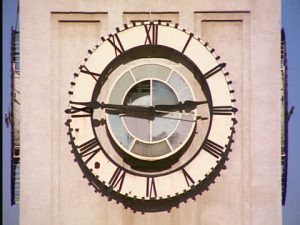Parking is extra, plus the rent is higher if you have a cat or a dog.
Where Will The Middle Class Live?
Parking is extra, plus the rent is higher if you have a cat or a dog.

Every schoolchild knows (or should know) that the number 4 in Roman numerals is IV. So why do clocks and watches that show the time in Roman numerals almost always use IIII for 4? (Take a look at the photo below of the clock tower atop the Ferry Building in San Francisco.) All the other numbers are shown correctly in Roman numerals. Only 4 is wrong, and it is wrong on most clocks and watches. It doesn’t seem to matter when or where the clock or watch was made. This has been going on for a long time. European clock makers have been using IIII for 4 for centuries. We don’t know who started this practice or when. There are a lot of theories about this, including conspiracy theories involving the Freemasons, the Illuminati, King Louis XIV of France, and the Pope. (There are a lot of wacky conspiracy theories floating around on the internet about the Freemasons, the Illuminati, and the Pope, but not many about Louis XIV.) One theory that has a lot of internet followers right now is that the Romans started putting IIII on clocks instead of IV as a way of honoring Jupiter (the god, not the planet). The problem with this theory is that mechanical clocks weren’t invented until centuries after the fall of the Roman Empire. However, the Romans made sundials with Roman numerals on them, so I suppose it is possible that the Romans started this practice themselves. I don’t know what the Romans put on their sundials for the number 4.

A lot of what people think they know about ancient Rome isn’t true. That all comes from Hollywood of course. Many of the most expensive and memorable movies ever made were about Rome. While movies about gladiators and deranged emperors are fun to watch, they are usually extremely inaccurate. One of the first movies I ever saw was about gladiators. It was a Saturday matinee at the Forest Theater in Baltimore. The movie scared me, which is why I remembered it. The gladiators in this movie were fighting dinosaurs in the Colosseum. Even though I was only about 8 years old at the time, I recall that I had serious doubts about the historic accuracy of this movie. Hollywood studios put dinosaurs into all sorts of movies back in those days. Remember Godzilla?  Westerns were very popular in the 1950s, so Hollywood sometimes put dinosaurs in them too. My favorite dinosaur Western was ‘The Valley of Gwangi’ in which cowboys on horseback chased down really big dinosaurs and then lassoed and hogtied them. I don’t remember why they were doing that. Below is a still shot from this movie. In this scene, the cowboys are taking a lassoed dinosaur off to market.
Westerns were very popular in the 1950s, so Hollywood sometimes put dinosaurs in them too. My favorite dinosaur Western was ‘The Valley of Gwangi’ in which cowboys on horseback chased down really big dinosaurs and then lassoed and hogtied them. I don’t remember why they were doing that. Below is a still shot from this movie. In this scene, the cowboys are taking a lassoed dinosaur off to market.
As I often tell my students – it is important to remember when you are watching movies about real historic people and historic times that Hollywood is in the entertainment business, not the education business.
P.S. – I am pretty sure that Roman gladiators did not fight with dinosaurs, but I will try to get confirmation of that from my Latin-teaching cousins in Cincinnati.
 This recipe only contains 2 ingredients and takes 5 minutes to make. If you want an excellent chocolate sauce that instantly hardens into a shell when poured over ice cream, here’s the secret: coconut oil. At room temperature, coconut oil is solid but spoonable; however, it becomes hard and brittle at colder temperatures, like the temperature of ice cream. You can buy coconut oil at many supermarkets and Trader Joe’s. To make a really good hard chocolate ice cream topping, place in a microwaveable bowl 1/3 cup (2.5 ounces) of coconut oil and 1 cup (6 ounces) of semisweet chocolate. Microwave at 50 percent power in 30 second intervals, stirring the mixture between the intervals until the mixture is thoroughly combined. That’s all there is to it! You can store your chocolate topping at room temperature and spoon or pour it over ice cream. If the mixture is too thick, add a little more coconut oil or microwave it slightly to warn it up. You can also use this mixture to make chocolate covered frozen bananas on a stick and other frozen desserts. (A jar of this stuff also makes a very nice Christmas gift from your kitchen!)
This recipe only contains 2 ingredients and takes 5 minutes to make. If you want an excellent chocolate sauce that instantly hardens into a shell when poured over ice cream, here’s the secret: coconut oil. At room temperature, coconut oil is solid but spoonable; however, it becomes hard and brittle at colder temperatures, like the temperature of ice cream. You can buy coconut oil at many supermarkets and Trader Joe’s. To make a really good hard chocolate ice cream topping, place in a microwaveable bowl 1/3 cup (2.5 ounces) of coconut oil and 1 cup (6 ounces) of semisweet chocolate. Microwave at 50 percent power in 30 second intervals, stirring the mixture between the intervals until the mixture is thoroughly combined. That’s all there is to it! You can store your chocolate topping at room temperature and spoon or pour it over ice cream. If the mixture is too thick, add a little more coconut oil or microwave it slightly to warn it up. You can also use this mixture to make chocolate covered frozen bananas on a stick and other frozen desserts. (A jar of this stuff also makes a very nice Christmas gift from your kitchen!)
Here’s another gem from my collection of badly written history homework assignments by junior high school students.
“In 1517, Martin Luther nailed 95 theocrats to a church door in Germany. That started the Protestant Reformation. After that, Protestants exploded all over Germany. Protestants also exploded in Denmark, Holland, and England. The Pope excommunicated Martin Luther King, but even that didn’t stop the Protestants from exploding, so the Pope gave up and threw in the towel.”